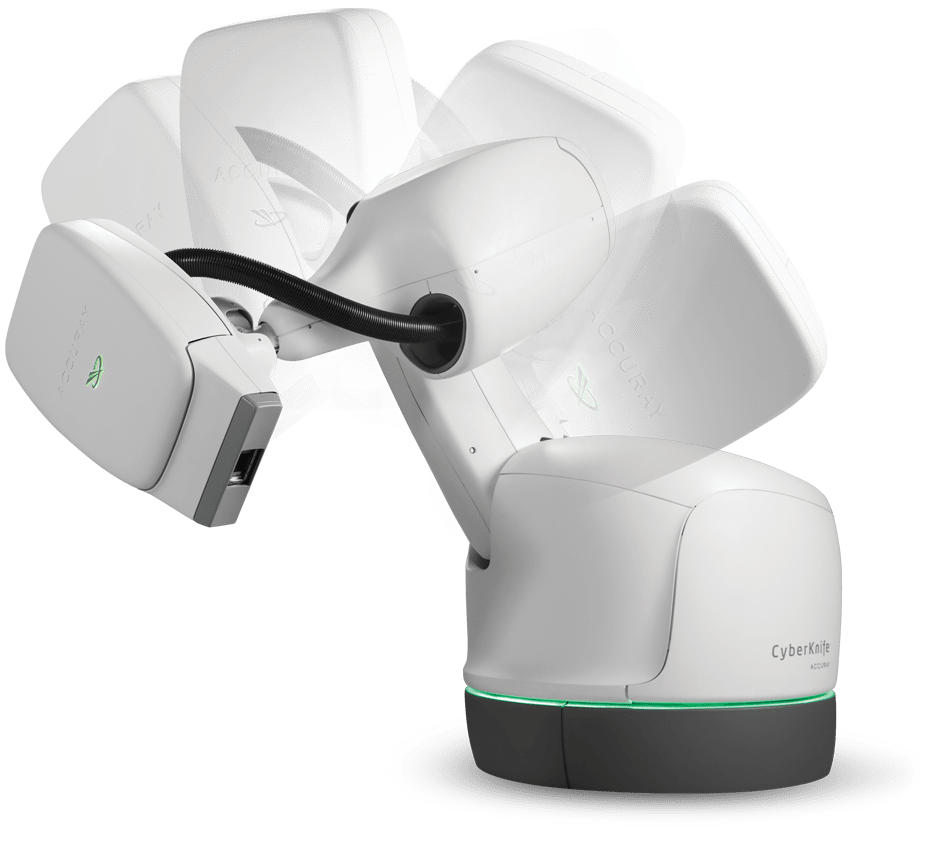The CyberKnife Robotic Radiosurgery System is a non-invasive alternative to surgery for the treatment of both cancerous and non-cancerous tumors anywhere in the body, including the prostate, lung, brain, spine, liver, pancreas and kidney. The treatment – which delivers beams of high dose radiation to tumors with extreme accuracy – offers new hope to patients worldwide.

The CyberKnife Robotic Radiosurgery System treats both cancerous and non-cancerous tumors anywhere in the body, including the prostate, lung, brain, spine, liver, pancreas and kidney.It provides a pain-free, non-surgical treatment to the patients with complex tumours which are un operable or too risky to be operated and to the patients who are looking for an alternative to surgery. To date, more than 100,000 patients have been successfully treated and more than 150 systems are installed worldwide.
Cyber Knife Radio Surgery
How Cyberknife RadioSurgery Works ?
As a non-invasive “operation”, CyberKnife has proven to be an effective alternative to surgery or conventional radiation for treating vascular abnormalities, tumors, functional disorders, and cancers with sub-millimeter accuracy. CyberKnife gives renewed hope and the possibility of a better quality of life, especially for patients with tumors previously diagnosed as inoperable, and for those who have already received the maximum amount of radiation through other treatment methods.
The CyberKnife uses non-invasive image-guided localization that is more convenient and less traumatic than other systems using the standard invasive stereotactic headframe (a rigid metal frame fixed to a patient’s skull for head immobilization and target localization). CyberKnife also uses an advanced, lightweight linear accelerator (LINAC), a device used to produce a high dose of radiation.
In addition, CyberKnife also has a robotic delivery system that not only provides the flexibility to reach areas of the body unreachable by other systems, but is also instrumental in precisely aiming the device.
The robotic delivery system integrates motion-tracking software, called the Synchrony System, with the robotics, making it accurate enough to even hit a moving target. As a patient breathes or moves slightly during treatment, the robot detects the motion and compensates in ‘real time’, ensuring that the radiation is accurately hitting the target (tumor) throughout treatment.
CyberKnife can strike the tumor with a high dose of radiation from over 1200 different angles. This pinpoint accuracy allows malignant or benign tumors to be obliterated without damaging critical healthy tissue.
How is CyberKnife Different ?
Standard stereotactic radiosurgery techniques rely on a rigid frame fixed to the patient's skull for head immobilization. There are other systems for extra-cranial Stereotactic Radiation. These systems are most often uncomfortable. If the target moves with the breathing of the patient, they often require breath holding techniques, which may be difficult for some patients. Frame-based systems mean there is a limit to the number of angles the radiation can be delivered through.
The CyberKnife System offers maneuverability and versatility that other systems cannot offer, therefore now making it possible to treat tumours anywhere in the body, especially the brain, spine, liver, lung, pancreas and prostate. The combination of image guidance with the help of X-ray cameras and the very latest computer technology ensures that the CyberKnife System is able to overcome the limitations of older frame-based radiosurgery systems, such as the Gamma Knife and LINAC based X-Knife.
Common Conditions Treatable By CyberKnife Radiosurgery
Astrocytoma, Glioma, Glioblastoma Multiforme, Oligodendroglioma
CyberKnife offers superior conformance to tumour shape, which is important especially for recurrence after surgery and conventional radiotherapy. CyberKnife can also irradiate the tumour bed to delay or prevent recurrence.
Brain metastases
Radiosurgery may be equal to surgery for single metastases and better for multiple metastases. Advanced imaging allows CyberKnife® to treat those that are widely dispersed.
Spinal Tumours
CyberKnife is regularly used to treat spinal metastases. It may also serve as a treatment for many primary spinal tumours.
Pituitary Adenoma
CyberKnife's staged treatments may help to avoid or minimize the risk of visual loss and other side effects associated with single-session radiosurgery. Its superior conformance minimizes irradiation of normal tissue, including the optic chiasm and hypothalamus.
Hemangioblastoma
CyberKnife non-invasively treats the tumour nodule, usually in one session, even in hard-to-reach areas. This is especially beneficial for Von Hippel Lindau disease patients who can become disabled by multiple surgeries.